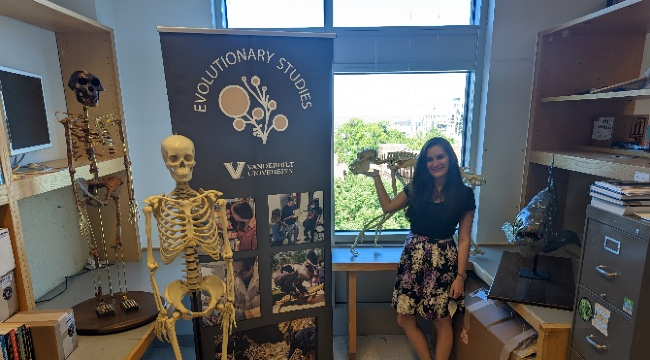
By Andy Flick
Annie Hatmaker, along with a team of researchers including her adviser, Cornelius Vanderbilt Professor of Biological Sciences Antonis Rokas, recently published a study identifying the differences in virulence among Aspergillus species. Aspergillus is a common human-pathogenic genus of fungi that includes A. flavus, which can cause aspergillosis and fungal keratitis infections, a type of eye infection.
Hatmaker and the team found that secondary metabolites—compounds produced that are not necessary for survival but can be advantageous in specific environments—differed among species at room temperature. Ramping the temperature up to 98 degrees Fahrenheit, the team found that the production rate of secondary metabolites increased considerably, likely because human body temperature is not the preferred environment for these fungi. They may be creating these secondary compounds to help cope with the relatively increased temperature.
Hatmaker’s work pushes the boundaries of our knowledge of the species complex beyond A. flavus, which is better studied in clinical settings than its sibling species. In fact, when fungal keratitis is diagnosed in a medical lab, the conclusion is often just Aspergillus, which can be useful for medical doctors but leave something to be desired for researchers seeking to have a better understanding of the evolution of Aspergillus and how it might be treated, or even predict which strains may become pathogenic in the future.
“If every clinical laboratory had money and equipment to sequence the genomes of all their fungal strains isolated from patients, we would see a lot finer resolution in which species are regularly infecting humans and more diversity in rare infections,” Hatmaker said. “The genus Aspergillus is incredibly diverse in a multitude of traits, so it ultimately would benefit the scientific community to have the genomes of species causing each infection available for further study.”
One important trait of these fungi species is the interaction between environment and pathogenicity. The natural environment they can be found in includes soil, which is subject to climate change—particularly, to global warming.
“In general, Aspergillus species produced more secondary metabolites at the higher temperature,” Hatmaker said. “Global warming could absolutely drive differences in virulence.”
The project was a collaborative effort among many scientists across several universities. Hatmaker worked with chemists at the University of North Carolina at Greensboro, microbiologists at the University of Sao Paolo in Brazil, and immunologists from the University of Oklahoma Health Science Center. The team leaned on the resources available at Vanderbilt University and Vanderbilt University Medical Center, particularly VANTAGE, the genomics core facility at VUMC, and ACCRE, the advanced computing center at VU.
One team member, renowned for his work in fungal diversity, is Nicholas Oberlies, the Patricia A. Sullivan Distinguished Professor in the Department of Chemistry at UNC, Greensboro. His lab has studied the chemistry of fungi for decades, but he said researchers can still be astounded from time to time.
“We were pleasantly surprised by the differences in phenotype (i.e., the suite of compounds produced) when changing from room to body temperature,” Oberlies said. “Hopefully the combination of our data, with those from the rest of the team, will help us to derive a better understanding of what A. flavus is ‘doing,’ broadly defined, when it infects humans.”
Hatmaker has been studying plant pathogens for the better part of a decade, beginning with training in molecular techniques at the University of Tennessee, where she graduated with a bachelor’s in ecology and evolutionary biology and later a master’s in genomics.
“For A. flavus, I’m most interested in the evolution of pathogenicity and in diversity within the species,” Hatmaker said. “You can find A. flavus on every inhabited continent. It can infect plants, it can produce some of the most famous toxins produced by fungi (aflatoxins), and it can directly infect humans—what an incredible range for one species.”
Hatmaker is supported by the National Institutes of Health National Eye Institute (F31 EY033235). Research in the Rokas lab is supported by grants from the National Science Foundation (DEB-2110404), the National Institutes of Health National Institute of Allergy and Infectious Diseases (R56 AI146096 and R01 AI153356), and the Burroughs Wellcome Fund.